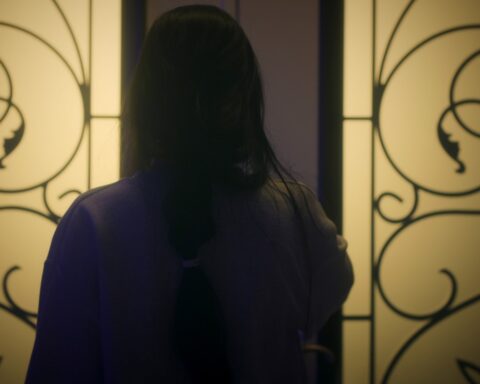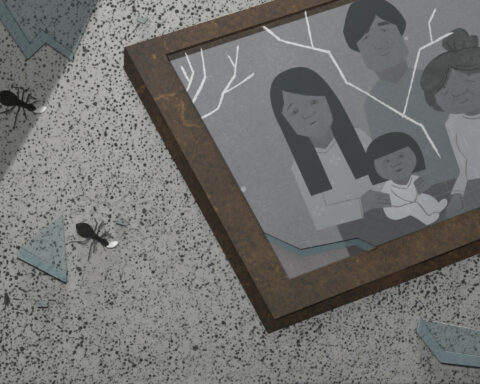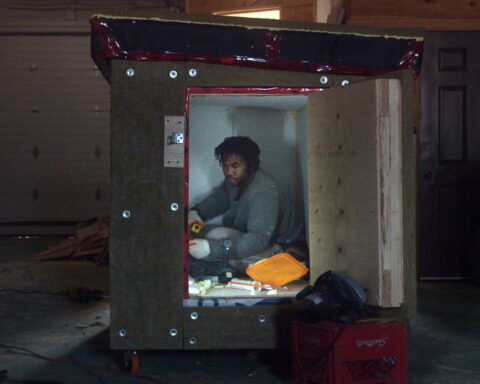“Why you, Moze?” The question was being asked of me by a young woman with a gorgeous cascade of afro curls. “Why you?” By “you” I knew immediately what she meant. The “you” was in reference to me, a white male filmmaker who was about to embark upon a project that would focus on predominately black youths. In other words, why was I, an outsider, making a film about a place where I have never lived?
It was the week before the start of filming on my feature documentary, My Piece of the City, and I was sitting before 10 youths from Toronto’s Regent Park. They had been gathered together inside a large neighbourhood studio space to ask me questions about how I was going to portray them in the film. Outside, one of the largest urban redevelopment projects in North America was underway that had seen many of their homes torn down in order to make way for gleaming new mixed-use condo hi-rises and townhouses. My film was going to focus on the youths’ experiences as they underwent this enormous, and potentially painful, change from a troubled inner-city community to one where expensive sports cars zoomed toward new cafes serving the latest organic quinoa salads and soy bean lattes.
“I wasn’t born here or lived here,” I offered, “but I think I have an idea as to what you are going through.” I explained to them that as an immigrant Persian Jew, I had seen my family exiled from their homeland for their beliefs, forever losing their tightly-knit communities in the process. I had witnessed that sense of loss where people realize they will never return to see the places in which they lived, worked or celebrated. “Yes, I’m white,” I continued, “but I have an idea as to what it’s like for a family to lose its home; to find itself in a world where things look alien; and where the future is filled with questions and uncertainty. I may seem like a stranger but I understand this place.”
I didn’t convince all of them but out of the ten youths gathered around me on that night, eight agreed to take part and collaborate with me on the film. And out of the eight, four contributed musical material, including rap, opera, pop and spoken word pieces. I used these musical segments as part of their storytelling in creating an intimate sense of all that they had experienced during the dramatic redevelopment of their community. The film is not a historical tract about Regent Park but rather a look at a specific moment as an old world is supplanted by a new one and what becomes lost along the way.
A quick and dirty primer on Regent Park goes something like this: The area, consisting of about 69 acres, is located to the east of Toronto’s downtown district, and was known as the city’s slums as far back as the early 1900s. By the late 1940s, the buildings were in such disrepair that a plan was hatched to raze everything to the ground and build a utopian entity known as a “Garden City.” The Brits had much to do with the initial concept, which turned into the controversial “council houses” over there. It failed miserably in Toronto, as cross-streets were taken out and the area become isolated from the rest of the city. Without through traffic, Regent Park became a heart with its arteries removed. Parkland and green spaces that were supposed to provide a bucolic paradise ended up becoming dark spaces where drug deals and criminal activity could take place. The media also contributed a great deal to the area’s tarnished reputation by covering every single killing or drug bust without much regard for the humanity of those arrested or accused, whether they were guilty or not.
Almost completely lost was the sense that despite Regent Park’s troubles, it was also home to hundreds of proud, tightly-knit families and passionate community leaders and activists like Diane MacLean, Gene Lincoln and Ken Slater. Artists like Point Blank and Smoke Dawg as well professional athletes like Trevor Daley and Glen Metropolit all came from Regent Park. They and countless other residents had provided the heart and soul of the neighbourhood but years of bad press and misrepresentation had relegated it to being the “hell hole of the city” in the words of one uncharitable Torontonian. Yes, the place certainly needed a massive change as the dwellings were crumbling amid calls for a better and healthier infrastructure. But how do you go forward without making the same mistakes that created such a tragic vacuum in the first place?
The answer came in the form of a proposal that the developer, The Daniels Corporation, presented to the City of Toronto in 2006. Rather than repair what was damaged, Daniels argued that the entire Regent Park had to be totally demolished and a new world created in its place that would address the needs of the community. (In Britain, a similar idea of “mixed tenure” housing was introduced in the 1990s and remains controversial). There would be a mixed-use arrangement where “market” housing (i.e. high-end condos and townhouses) would be integrated with subsidized housing. The crux of the plan was the addition of a robust infrastructure that would include, amongst other structures and services, an Aquatic Centre, a Recreational Centre, an arts facility (The Daniels Spectrum) which would contain two theatres and a home base to over a dozen organizations, and plenty of green space for baseball, soccer or football. “If you build it well, they will come,” was the hopeful thinking. The plan was certainly different and daring with an emphasis on creativity, liveability and sustainability. What could possibly be overlooked with this unique vision? Well, this is where my documentary came in.
As part of the redevelopment of Regent Park, the Daniels Corporation had sponsored an annual community show titled, “The Journey.” It’s creator, Mitchell Cohen, who also happens to be the company’s President, brought together the stories of the youth, as well as their elders, into a full-length musical that explores their struggles and experiences over the redevelopment phase. [Full disclosure: Even though the Daniels Corp. is one of the main financiers of my documentary, I retained complete artistic and editorial control over the entire project.] Many of the stories are heartbreaking and it seemed right that I should focus on the development of this musical as the trunk of the film from which the youths’ personal stories would branch out. But as filming began, something startling happened to me: Everything I thought was true about Regent Park proved to be false. The reality that I held in my head was practically fiction. I came expecting an optimism about the future as promised by the huge changes to the community but what I discovered was a deeper sense of loss for a world that despite its troubles, had been a loving and nurturing home for most of the youths.
“When it comes to Cabbagetown and Riverdale, you have these places where people feel strongly about keeping their history and preserving their buildings. But then you take two steps across the street and you have all this mass construction in Regent Park,” explains Jael, a young woman in the film. “And I feel like they [the city planners] basically stomped all over Regent Park. And what they’re saying is basically that your history is not good enough for us to keep.” Like so many of her friends, Jael saw their old residences, schools and playgrounds flattened to make way for a new world order. As much as the old places were run down and in terrible shape, there was a sense of loss that was difficult to negotiate. “I feel like my memories from my childhood are gone now,” adds Jael. “Change is not necessarily bad but at the same time it makes me feel weird because I’m wondering where are all these memories going? Whose community does this new one belong to now?”
Stacy, an aspiring opera singer, adds to what Jael, her best friend is saying: “Little characteristics that I remember from my childhood are now blurs and it’s sad because those are pieces that I grew up with. And whether they were tough or ugly, those pieces were part of my world growing up here. So, it’s hard to see what this neighbourhood is becoming.”
Both Jael and Stacy bring up something that gets short shrift in the way we think about urban redevelopment and gentrification. For as much as we lament the loss of “heritage” or “history,” what actually happens to that more fragile sense of personal or collective memory that becomes orphaned? Do we make a kind of taxidermy tribute to those memories in the same way architects play lip service to a building’s history by keeping only it’s stately front entrance?
“It’s still hitting home,” explains Bradley, a young man from Regent Park. “I’m in a place where I still feel I can’t believe it’s happening. There definitely is a separation here. A deep separation [between the old and new residents].” Standing next to him is Ridge, an up and coming rapper who adds: “Before, I hated this redevelopment. It’s heartbreaking but I learned in life that you just have to move on.”
Still, despite what has been lost for the youths and the uncertainty of whether this $1 billion redevelopment will heal some of the wounds of the past, I had an overall sense from most residents that there is still hope that this union between commerce and social responsibility might succeed, like an arranged marriage where two strangers are brought together to form a lifelong partnership, and do so with love and respect, despite great odds and differences.
“I know for sure that we’ll be losing a culture, the Regent Park culture; and that is scary,” explains Gene Lincoln, a community development worker and one of the neighbourhood’s sage elders. “There is no perfect solution and not even Jesus Christ could’ve done it; so, don’t expect this redevelopment to do it by itself. It’s going to take some work and creativeness and people with vision, and not bias, to bring us together.”
My Piece of the City airs on CBC’s Absolutely Canadian on Saturday, November 17th at 1 pm.
Read more about the project in The Journey to a Web Series.
My Piece Of The City – Trailer from 100 Dragons on Vimeo.











